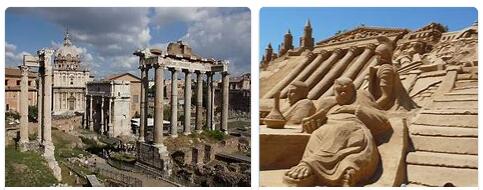Roman Early History
Roman history, the history of the ancient city of Rome and the state that it founded.
Beginnings and royal times (until 509 BC?)
Rome arose on the foothills of the Apennines, where an old salt road (Via Salaria) crossed the Tiber, which separated the territory of the Etruscans from that of the Latin tribes. Already in the 10th / 9th Century BC Chr. (Early Iron Age) populated Palatine Hill (Latins), Capitol, Quirinal and Esquiline (Sabines) were probably in the 7th century by the Etruscans by including the dewatered Forum sink to a city with the Etruscan name “Roma” (originally. Well » Ruma «, derived from a gender name). Like the conventional founding date (April 21, 753 BC; era, Section Roman Era) are also the early history of Rome, the royal period and the first centuries of the republic, largely a later reconstruction, since Roman historiography only began at the end of the 3rd century BC. Begins. Archaeological evidence and the Romans’ adherence to old, often deprived of their function, institutions and legal norms, however, allow more or less reliable statements to be made about earlier Roman history. The names of the seven kings (Romulus, Numa Pompilius, Tullus Hostilius, Ancus Marcius, Tarquinius Priscus, Servius Tullius, Tarquinius Superbus) are legendary, but partly preserve the memory of the Etruscan rule.
The (elected) King (Rex) was supported by a council of the elders (Senatus). The old military assembly (Comitia curiata) was divided into 30 curiae, ten from each of the three gender associations (tribe) that had Etruscan names. During the royal period (allegedly under Servius Tullius), four local urban tribes were created as evacuation districts for the heavily armed infantry, divided into (initially 40?) Centuries (hundreds) (hoplite tactics based on the Greek model). With the expulsion of the last king, Tarquinius Superbus The Etruscan period came to an end (according to the tradition 509 BC), which was later regarded as national liberation. Decisive for the overthrow of the Etruscan kingdom were probably the strengthening of the patrician families within and the decline of the Etruscan power in general; possibly even the Etruscan defeat in the naval battle of Kyme (Cumae) in 474 BC. BC against Hieron I of Syracuse was the last impetus for the liberation of Rome from the Etruscans and from kingship. Etruscan elements lived, however, among other things. continued in cult and in the symbolism of power.
Republic (509 BC? To 27 BC)
Constitution: The leadership of the state was taken over by the mounted nobility of the patricians, who also formed the Senate. At the top were probably two elected officials with authority from the start (later called Consules, Consul). The one year term of the office (annuity) and the equality (collegiality) of the owners should prevent usurpations. The burden of war and indebtedness led to tensions with the non-patricians, the plebeians (plebs), whose number rose steadily due to the influx of Italian families. This politically less legitimate plebeians chose to own leaders, the tribune (tribune), and created their own Assembly (Concilia Plebis). Through collective conscientious objection to military service (Secessio Plebis), the heavily armed infantry enforced a legal codification (Twelve Tables Act) around 450 and, as an upper class within the plebs, obtained permission to marry the patricians as well as access to the consulate (367/366) and the priesthood (300 BC). Chr.). In 287 the resolutions of the plebs received general legal force. The result of these “class struggles” was the formation of a new official nobility, the nobility, to which everyone belonged who himself or his ancestors had held one of the highest offices (later the consulate). The increase in offices in the 3rd century led to the development of a fixed office career (Cursus Honorum).
Rome and Italy (until 264 BC): In terms of foreign policy, the overthrow of the kingship and a temporary agreement with the Latins (Foedus Cassianum 493?) Was followed by the first expansion of power in central Italy (396 conquest of the Etruscan Veji), which, however, was triggered by the invasion the Celts experienced a severe setback (probably July 18, 387 – according to another dating 390 – defeat on the Allia, capture and destruction of Rome, which had been vacated by the residents, with the exception of the Capitol, Brennus). From the middle of the 4th century Rome won wars against the Latins, Etruscans and Samnites the supremacy in central Italy (three Samnite Wars 343–341, 328–304 and 298–290; Latin War and dissolution of the Latin Confederation 340–338). Rome now asserted its influence in southern Italy and came into conflict with the Greek Taranto in 282, for whose defense the Molossian king Pyrrhos I moved to southern Italy in 280. The war ended in 272, after the victory over Pyrrhos I at Benevento (275) and his retreat to Greece with the submission of Taranto. Rome thus commanded all of Italy south of the Po Valley.
Rome secured its rule over Italy through annexations – expansion of the Ager Romanus (232 distribution of Ager Gallicus to Roman citizens by Gaius Flaminius), increase of the local tribes (since 241) 35 – through colonies under Roman and Latin law and a system of alliances and dependencies as well as by creating roads. During the war with the Samnites, the old hoplite tactic was replaced by manipulartactics (Manipel) and the number of Centuries increased. The centurial assembly (Comitia centuriata, most recently 193 centurions in five census classes) was the most important popular assembly since 450. the consuls, praetors and censors were elected. In addition, the assembly of the tribes (Comitia tributa) gained in importance (inter alia for the election of the lower magistrates with the exception of the plebeian officials who were elected in the Concilia Plebis).



